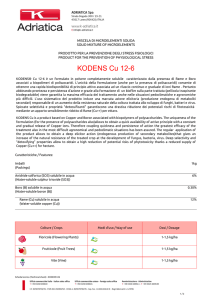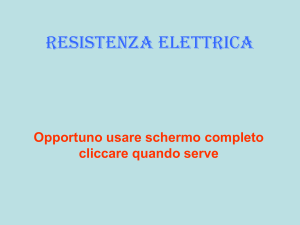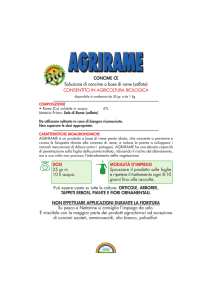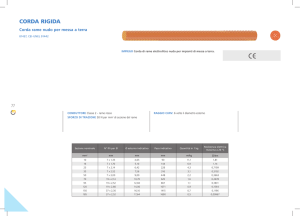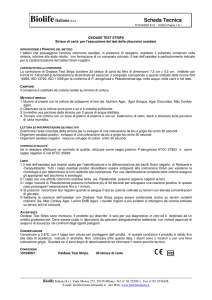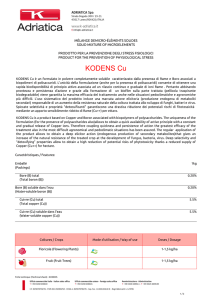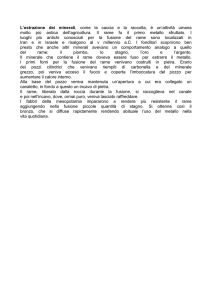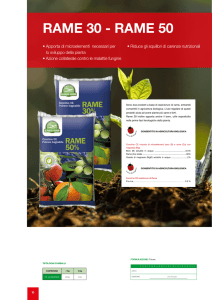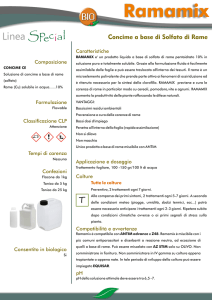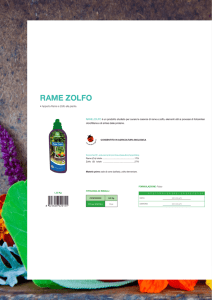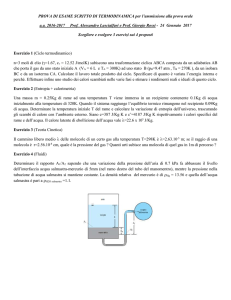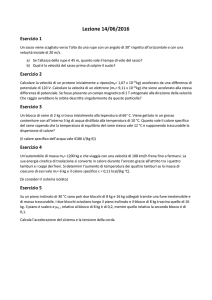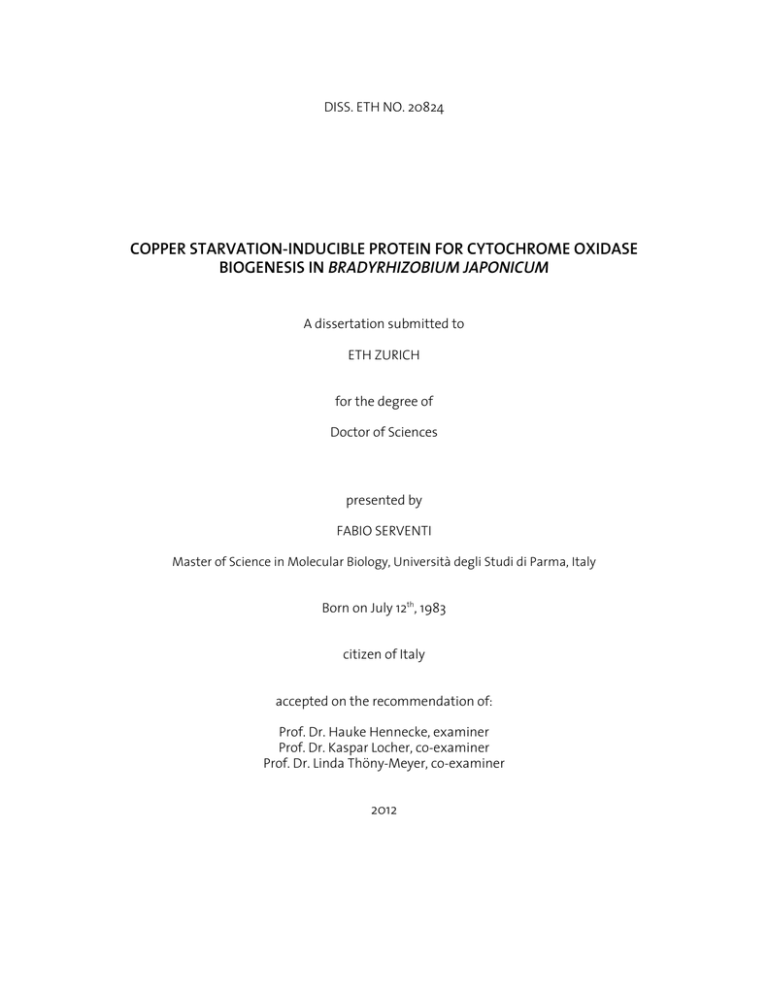
DISS. ETH NO. 20824
COPPER STARVATION-INDUCIBLE PROTEIN FOR CYTOCHROME OXIDASE
BIOGENESIS IN BRADYRHIZOBIUM JAPONICUM
A dissertation submitted to
ETH ZURICH
for the degree of
Doctor of Sciences
presented by
FABIO SERVENTI
Master of Science in Molecular Biology, Università degli Studi di Parma, Italy
Born on July 12th, 1983
citizen of Italy
accepted on the recommendation of:
Prof. Dr. Hauke Hennecke, examiner
Prof. Dr. Kaspar Locher, co-examiner
Prof. Dr. Linda Thöny-Meyer, co-examiner
2012
Summary
Copper is both a trace and a toxic element. The Cu2+/Cu+ couple potential is the highest
among the biometals, making copper usage by life convenient for the extraction of electrons
from molecules with already high redox potentials. For this chemical property copper
enzymes are involved in electron transfer and redox reactions, for example in aerobic or
anaerobic respiratory processes. For the same property, and because it is the most effective
metal in binding biomolecules, copper is able to misplace other metal ions and/or catalyze the
production of reactive oxygen species. In bacteria, this toxicity is a major menace both in the
cytoplasm and in the periplasm. To deal with it bacteria compartmentalize copper enzymes
outside the cytoplasm, where the most sensitive targets are located, use efficient efflux
systems, and use metallochaperones to tightly control its transport to copper enzymes. In
copper starvation conditions it is possible that import systems collaborate with
metallochaperones in a more complex trafficking system.
Such copper chaperones have been described mainly for the biogenesis of heme-copper
oxidases in mitochondria and in their prokaryotic relatives belonging to the α-proteobacteria
class like Rhodobacter and Bradyrhizobium japonicum. In the eukaryotic model, adopted also
for prokaryotes, Sco1 transfers copper to (or reduces its cysteines of, or both) the CuA center
of the cytochrome c oxidase, and Cox11 is responsible for the CuB center. Recently Sco has
been linked to the biogenesis of CuB centers in prokaryotic aa3 and cbb3 oxidases (the latter
containing only a CuB center) as well. Biogenesis of the cbb3 oxidase does not require Cox11like proteins but instead is dependent on the integrity of predicted inner-membrane
transporters. PCuAC protein has been identified as a collaborator of Sco for copper transfer to
its same targets (CuA and CuB centers of aa3 oxidase and CuB center of cbb3 oxidase).
The abundance of alternative terminal oxidases, most of them copper-dependent, is
peculiar to the nitrogen fixing B. japonicum, and allows it to undergo different lifestyles such
as free-living aerobiosis and anaerobiosis, and symbiosis (mainly with soybean). It has been
shown that ScoI (Sco1-like) and CoxG (Cox11-like) collaborate for the biogenesis of the
main aerobic aa3-type cytochrome c oxidase in B. japonicum, while for the symbioticallyessential cbb3 oxidase the situation is less clear, but genes belonging to the fixGHIS operon,
among them a predicted P1B-type ATPase as product, are necessary.
This work aimed at identifying genes involved in copper import and trafficking in B.
japonicum. For this reason, a transcriptomic survey of genes up-regulated in copper
starvation and a search for copper chaperone homologues were carried out. Both approaches
converged in the identification of an operon, pcuABCDE. This operon is the only genomic
region whose expression is higher in copper-free medium compared to copper excess. It
1
encodes putative polypeptides related to copper trafficking, among them the PCuAC
homologue PcuC.
Strains with a resistance cassette replacing the operon were constructed and different
phenotypes were evaluated. Importantly, the mutants were found to be defective in copperstarved growth, in anaerobic growth and in symbiosis. To check whether the phenotype is due
to impaired biogenesis of the terminal oxidases, quantitative measurements of the aa3 and
cbb3 oxidase activites were carried out, revealing decreased functionality for both of them.
Interestingly, the defect of the aa3 oxidase is restorable with copper supplementation. The
cbb3 oxidase misfunction is evident only when the activity is tested on bacteroid membranes,
while in free-living anaerobic cultures (where the cbb3 oxidase is also expressed) the defect is
absent. The logical follow-up of the operon mutant characterization has been the creation of
strains in which each single gene has been deleted, in order to assign to each ORF a weight in
the different phenotypes observed for the whole operon mutant. Surprisingly, except for the
anaerobic growth, for which seemingly all the genes have a partial role, the lack of pcuC was
found to be the only determinant of the ΔpcuABCDE strain phenotype.
Phenotypes of ΔscoI (previously characterized in this group) and ΔpcuC are strikingly
similar. As for ΔpcuC, the cbb3 oxidase activity of ΔscoI is not impaired when membranes
are isolated from anaerobically grown cells. The cbb3 oxidase activity of bacteroid
membranes was then measured in the ΔscoI strain as well, as this has not been tried formerly,
and importantly revealed a strong defect, as for that observed in ΔpcuC.
Furthermore, in-vitro studies confirmed the hypothesized Cu+-binding nature of PcuC via
conserved residues previously identified in the Thermus thermophilus homologue.
ScoI and PcuC are copper-binding proteins collaborating for copper insertion into the cbb3
oxidase and into the aa3 oxidase. These results are compatible with what has been
concurrently observed in Pseudomonas aeruginosa PA01, Rhodobacter sphaeroides and
Rhodobacter capsulatus, enforcing both a new view of the role of Sco, which is no longer
restricted to the copper transfer/reduction of CuA centers, and its close link to PCuAC. In this
model it would be more likely that the soluble PCuAC binds copper as it enters the periplasm
and transfers it to the inner membrane-anchored Sco, which then sorts it to membrane bound
chaperones/copper-enzyme targets. In order to assess the validity of this model further in
vitro copper transfer studies are needed.
2
Riassunto
Il rame è sia un oligoelemento sia una sostanza tossica. Il potenziale della coppia Cu2+/Cu+
è il più alto tra i biometalli, rendendo il rame utile per l’estrazione di elettroni da molecole
con un potenziale redox già elevato. Per questa caratteristica i cuproenzimi catalizzano
principalmente trasferimenti di elettroni e reazioni redox, come ad esempio in svariati
processi respiratori aerobici o anaerobici. Questa stessa caratteristica è però, assieme al fatto
che il rame è il metallo che lega più efficientemente le biomolecole, anche il motivo della sua
tossicità; infatti, esso può catalizzare la produzione di specie reattive dell’ossigeno e/o
sostituire altri metalli. Nei batteri questa tossicità rappresenta una minaccia sia nel citoplasma
che nel periplasma. Essi devono perciò evitare che atomi di rame rimangano liberi all’interno
della cellula relegando i cuopronezimi fuori dal citoplasma, dove si trovano i bersagli più
sensibili, utilizzando efficaci meccanismi di esporto e usando chaperones che scortano il
metallo a destinazione. Quando il rame diventa limitante, è possibile che sistemi d’importo
collaborino con chaperones in un più complesso network di smistamento.
Chaperones di questo tipo sono state descritte principalmente per la biogenesi di ossidasi
terminali a eme-rame nei mitocondri e nei loro parenti procariotici più stretti appartenenti al
gruppo degli α-proteobatteri, come Rhodobacter e Bradyrhizobium japonicum. Nel modello
eucariotico, che è stato adottato anche per i procarioti, Sco1 trasferisce il rame nel centro CuA
della citocromo c ossidasi (o riduce le sue cisteine, o entrambe le cose), mentre Cox11 si
occupa del centro CuB. Più recentemente a Sco è stato attribuito un ruolo nel trasferimento
del rame anche nel centro CuB delle ossidasi aa3 e cbb3 (quest’ultima contenente solo un
centro CuB). La biogenesi dell’ossidasi cbb3 non dipende da proteine del tipo Cox11, ma
piuttosto da putativi trasportatori della membrana citoplasmatica. PCuAC inoltre sembra
collaborare con Sco per la biogenesi dei suoi stessi bersagli.
L’abbondanza di ossidasi terminali, la maggior parte delle quali contenenti rame, è una
peculiarità dell’azotofissatore B. japonicum, e permette a questo batterio di adottare diversi
stili di vita, quali replicazione in aerobiosi e anaerobiosi, o simbiosi, principalmente con
piante di soia. È stato dimostrato che ScoI (omologo di Sco1) e CoxG (omologo di Cox11)
sono necessari per la biogenesi dell’ossidasi aa3, preponderante in aerobiosi, mentre non è
chiaro come il rame sia inserito nell’ossidasi cbb3, essenziale in simbiosi, anche se l’operone
fixGHIS, contenente tra gli altri un gene per un’ATPasi di tipo P1B, è necessario.
Lo scopo iniziale di questo lavoro è consistito nell’identificazione di geni per l’importo e
lo smistamento del rame in B. japonicum. A questo scopo sono state effettuate un’analisi
trascrittomica dei geni la cui espressione è aumentata in assenza di rame, e una ricerca di geni
omologhi a quelli codificanti chaperons note. Entrambi gli approcci hanno portato
3
all’identificazione dell’operone pcuABCDE, i cui geni sono gli unici a subire una upregolazione in terreni privi di rame rispetto a terreni con eccesso di rame. Le proteine
teoricamente codificate da questi geni sono correlate con il trasporto del rame; tra di esse c’è
PcuC, un’omologa di PCuAC.
Ceppi in cui l’operone è stato rimpiazzato da una cassetta di resistenza sono stati creati e
analizzati per diversi fenotipi. La mancanza dell’operone causa un difetto di crescita in terreni
privi di rame, in terreni anaerobici e in simbiosi. Successive analisi hanno dimostrato che la
causa di questo fenotipo è la mancanza di attività delle ossidasi aa3 e cbb3. L’attività
dell’ossidasi aa3 è ripristinabile crescendo le cellule in eccesso di rame, mentre l’ossidasi
cbb3 risulta difettosa quando le membrane sono estratte da batteroidi, ma non quando sono
estratte da cellule coltivate anaerobicamente (nelle quali la cbb3 ossidasi è comunque
espressa). Questo studio è stato approfondito creando ceppi mutanti per ciascun gene
dell’operone e osservando nuovamente i fenotipi analizzati in precedenza, allo scopo di
capire quale gene è responsabile per ciascun fenotipo. Sorprendentemente la mancanza di
pcuC si è dimostrata l’unica causa per i tutti i fenotipi osservati nel ceppo ΔpcuABCDE
eccetto la crescita anaerobica, alla quale tutti i geni sembrano contribuire.
I ceppi ΔscoI (caratterizzato precedentemente in questo gruppo) e ΔpcuC condividono un
fenotipo praticamente identico. Come in ΔpcuC, l’attività dell’ossidasi cbb3 in ΔscoI è
paragonabile a quella del wild type quando le membrane sono estratte da colture aerobiche.
Anche per ΔscoI è stata quindi analizzata l’attività di cbb3 in membrane estratte da batteroidi,
dal momento in cui ciò non era stato tentato in passato. L’attività misurata è risultata
fortemente ridotta, analogamente a quanto osservato in ΔpcuC.
Studi in vitro hanno confermato che PcuC è una chaperon del rame, essa lega infatti Cu+
tramite i residui conservati precedentemente identificati nella corrispondente PCuAC di
Thermus thermophilus.
Concludendo, ScoI e PcuC sono entrambe proteine che legano il rame, collaborando per la
sua inserzione nelle due ossidasi. Questi risultati sono compatibili con quanto riportato per
Pseudomonas aeruginosa PA01, Rhodobacter sphaeroides e Rhodobacter capsulatus, e
rafforzano l’idea che la funzione di Sco non sia limitata al trasferimento del rame (o alla
riduzione delle cisteine) del centro CuA, ma che piuttosto essa collabori con PCuAC per la
biogenesi dei centri CuA e CuB. In un tale modello è logico immaginare che PCuAC, solubile,
leghi il rame appena esso entra nel periplasma e lo trasferisca a Sco, che a sua volta lo
smisterebbe alle chaperones e agli enzimi associati alla membrana. La validità di tale modello
richiede comunque un’attenta valutazione tramite studi in vitro sul trasfermiento del rame.
4

